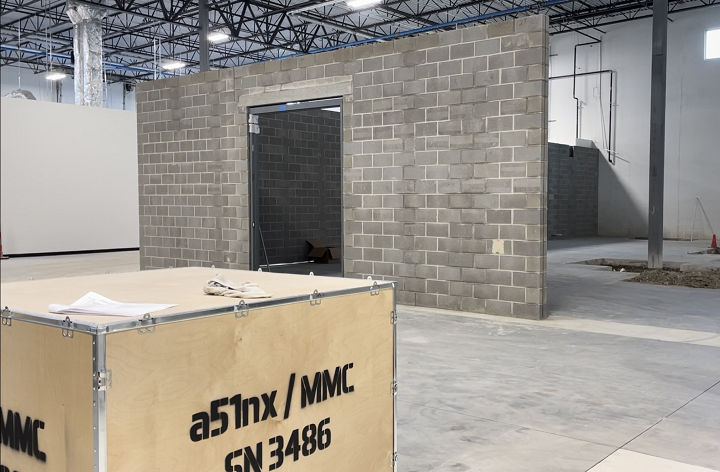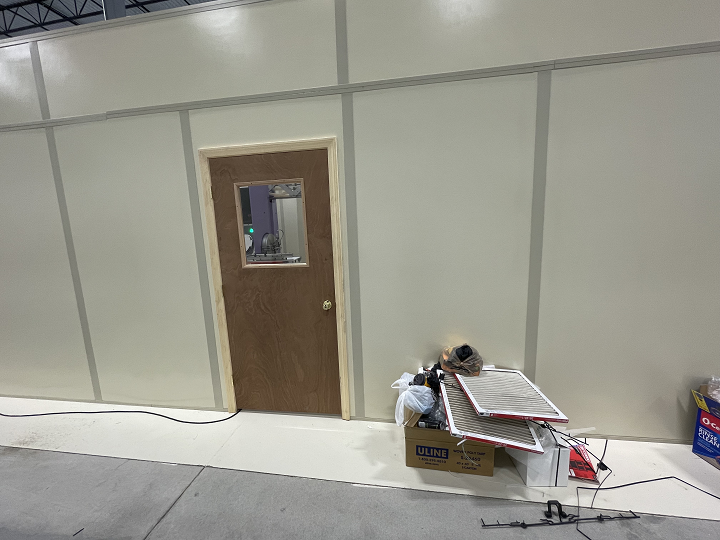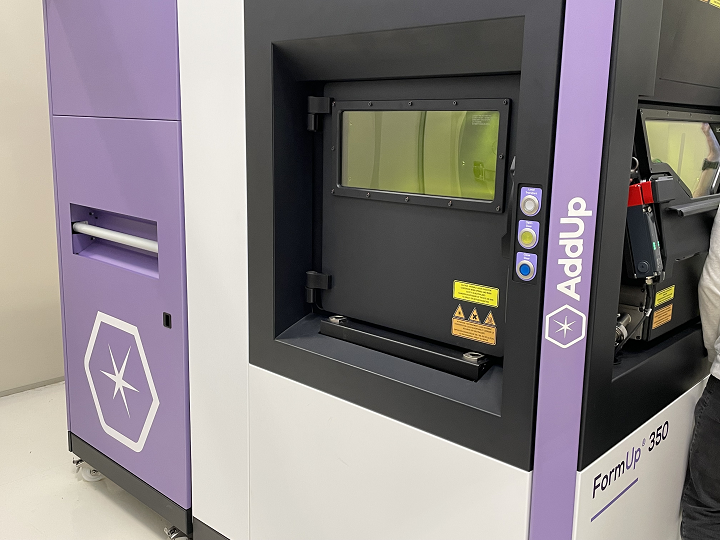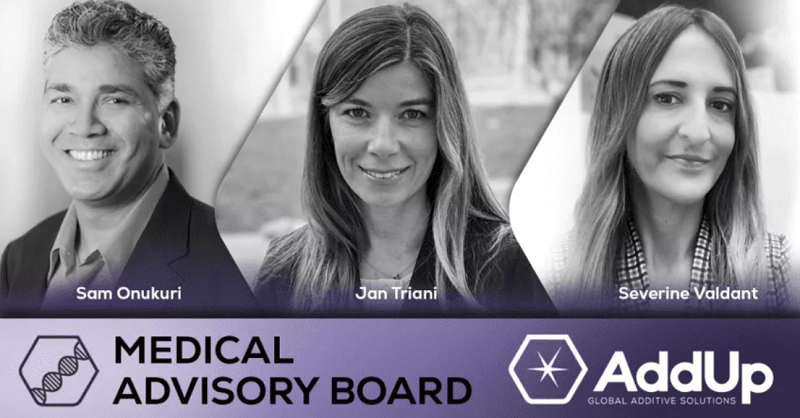In the first post in this series, I gave an overview of some of the operations and automation that will take place at the new 73,000-square-foot facility being launched by Zeda. The company, formed through the acquisition of Vertex Manufacturing by PrinterPrezz, combines the aerospace, space, and industrial expertise of Vertex with PrinterPrezz’s medical device specialty. In Part 2, I went into greater depth about how the site was planned and how it fits into the larger idea of re-shoring manufacturing to the United States. Now, I’m focusing on the eight AddUp 3D printers that will be deployed at the facility, the first of which is already there.
“There’s a natural reason we like AddUp,” Zeda’s CEO Shri Shetty half-jokingly told me during my tour of the facility. “Because they are purple and we are purple as well.”
Rush LaSelle, CEO of AddUp, agreed, saying it was “destiny” to partner with industry veterans.
“This has been a really good partnership for us, because, they [Zeda] are super humble, but in addition to the uniqueness of this facility, we think the greatest value is their experience in bringing new applications online reliably, quickly, and cost-effectively for people like GE Aviation, where Greg [Morris] has, you know, quite a bit of pedigree. But that gives a lot of comfort to people who are struggling to feel good about moving from castings or CNC into this space, that they can look at someone who’s done this before, is getting kind of a 2.0 or 3.0 view of it, and you know, now they can bring their parts here and feel pretty confident that they’ll get them the way they want.”
 Greg Morris, CTO of Zeda and Rush LaSelle, CEO of AddUp welcome the placement of the first FormUp350 system at Zeda’s new 75,000 square foot facility in Cincinnati, OH.
Greg Morris, CTO of Zeda and Rush LaSelle, CEO of AddUp welcome the placement of the first FormUp350 system at Zeda’s new 75,000 square foot facility in Cincinnati, OH.One of AddUp’s printers is already onsite at the Zeda facility, and prints with Inconel 718. I asked LaSelle when the next FormUp 350 laser powder bed fusion (LPBF) 3D printer would be deployed at Zeda, and the short answer was “within the first six months” of the facility being fully operational.
“Some of it’s being paced by facilitation, and then some of it’s just basic contract qualification,” he continued. “But I’d probably say that within nine months, those eight machines will have been consumed, or at least programs identified to consume them. And then hopefully we move forward from there.”
In fact, two machines have already been staged, the other of which is a titanium printer at AddUp’s nearby facility that’s currently being run and qualified for medical applications and will soon be at the Zeda factory; LaSelle said that “it’s in effect delivered, just at the wrong facility.” A separate room is being built on the floor at Zeda specifically to house titanium 3D printers, which will help ensure traceability, and as soon as that is built out, AddUp will install this second FormUp 350 inside. A third printer will be used for DoD opportunities in stainless steel, and in about three to four months, an aluminum tool from AddUp will arrive to the Zeda facility as well, for aerospace applications.
“So we’ll have had this tool in place, which is the Inconel,” he said about the printer already at Zeda. “We’ll have had titanium, which is going through IQ now for medical. We’ll have this 17-4 stainless steel tool for DoD, and then the aluminum. So we’ll have kind of all the flavors of ice cream in here again within three or four months, so that’s really great.”
I’d previously asked Morris how much automation Zeda anticipated using at the facility, and he said it would be a fair amount; I saw some of it on my tour. LaSelle and I continued this conversational thread inside the standalone room where the AddUp printers will be kept, with the exception of the titanium system. I asked if AddUp’s previous work with the AZO Group in automating powder handling for metal 3D printing would be on display at Zeda, and he said that the system has matured since 2021, and was actually already integrated and factory-ready to control the powder.
“You heard about how that room had to be special to accommodate titanium. Well, this actually is another layer of protection because all the titanium can be managed in an inert environment.”
He explained that one of the two “primary benefits” of the automated powder handling system is improved operator safety, and the other is more consistency of material for processing, both of which are obviously of paramount importance.
“So yes, we are using a lot of automation here, and then the associated monitoring and control of the powder. Because with titanium in particular, it really doesn’t like to have oxygen pickup—it changes the chemistry and ultimately changes the quality of the part, whether it’s going into a body or it’s going into an aircraft. So we think that this is a little bit more of an elegant solution from the ultimate quality of the parts as well. And it also reduces the amount of inventory of powder that has to be handled. So there’s a lot of goodness, but those are the two primary things that we’re really excited about with the AZO unit.”
I asked LaSelle what was coming for AddUp in the immediate future, and he said the company was working on “some interesting developments” within the healthcare space, though potentially with a partner other than Zeda. Since my visit to Zeda, the company has released one major healthcare-related piece of news—the establishment of a medical advisory board, as well as the appointment of three industry leaders to the board. These founding members are Sam Onukuri, Jan Triani, and Severine Valdant, each of whom has plenty of expertise in medical devices and healthcare. The mission of the board is to give AddUp a holistic, non-biased view of the medical industry, specifically as it relates to using metal 3D printing, and these new board members will certainly deliver.
Most recently the Global Head and Senior Fellow for Johnson & Johnson’s 3D Printing Innovation and Customer Solutions divisions, Onukuri has worked to speed up commercialization of 3D printing, specializing in both digital customer delivery models and healthcare applications. Triani is a subject matter expert for FDA audits, having authored 510(k)s, HDE, complete Quality Management Systems, 483 and Warning Letter responses. She founded Triani Consulting, developed and established initial QMS for two startup medical device companies, led Stage I and Stage II assessments with BSI, achieved 13485 certification with no major non-conformities, and much more. Finally, Valdant was most recently the President at Oxford Performance Materials, Inc. (OPM) and helped it evolve from a polymers company to an additive and medical device manufacturer, after which it became the first—and only—company to receive FDA approvals for 3D printed polymeric permanent implants. She is currently Chief Commercial Officer for QuesTek Innovations LLC.
“We are honored to welcome three industry veterans to our newly formed Medical Advisory Board. These professionals have proven track records of leveraging additive technologies in safe and reliable manners to improve patient care,” LaSelle said in a press release. “Mr. Onukuri, Ms.Triani, and Ms. Valdant will provide unique perspectives in advising AddUp, Inc as we continue advancing our metal 3D printing technologies, software, monitoring suites, and service offerings to empower companies to accelerate the adoption of additive manufacturing and all its benefits in delivering safe and affordable orthopedic care.”
The other piece of news AddUp recently released is its expansion into Germany, as it will soon officially open the doors to a new Tooling Competence Centre, located in Aachen within the WBA Tooling Academy, a leading partner of the tool and die industry in industry consulting, further education, and research.. This is the company’s second AM facility outside its home country of France, and a new office in Aachen will also serve as its Germany subsidiary AddUp GmbH.
The company has plenty of experience developing applications and materials within the tooling industry, as PBF technology makes it possible to produce tools with multiple parts more quickly, and with complex geometries and cooling channels as well. The new Tooling Competence Centre will be a useful resource to help tooling manufacturers validate their applications, and the facility is already equipped with a FormUp 350 printer. Tool makers will be able to submit applications cases for evaluation, and study every aspect of their project, including design, profitability analysis, and series production study.
 AddUp’s new Tooling Competency Centre
AddUp’s new Tooling Competency Centre“We couldn’t be more excited about the opening of our Tooling Competence Centre at the WBA in Aachen,” Julien Marcilly, Deputy CEO of AddUp, said in a press release. “Germany has a rich history in the tooling sector and AddUp is ready to support metal additive manufacturing adoption within this industry by showcasing our know-how in AM technology, productivity, quality and safety using the FormUp 350. We are looking forward to providing our customers in the tooling industry complete support for their metal 3D printing projects through this Tooling Competence Centre.”
AddUp will celebrate its new AddUp Tooling Competence Centre at a Grand Opening on May 10th, 2023. The event is free and open to the public and local businesses, and will feature a ribbon-cutting ceremony, facility tours, technical presentations, and local food and drinks. If you can’t make it to Germany in May, you can come visit AddUp at next week’s RAPID+TCT in Chicago at Booth #4636.
Subscribe to Our Email Newsletter
Stay up-to-date on all the latest news from the 3D printing industry and receive information and offers from third party vendors.
Print Services
Upload your 3D Models and get them printed quickly and efficiently.
You May Also Like
U.S. Navy Lab Uses 3D Printing to Reduce Tooling Lead Time By Over 90%
The F-35 Lightning II Joint Program Office (JPO), responsible for life-cycle management of the key fifth-generation joint strike fighter (JSF) system used by the U.S., its allies, and its partners,...
Etsy Design Rule Change Reduces Selection of 3D Printed Goods
Online marketplace Etsy has implemented a rule change requiring all 3D printed goods on the site to be original designs. The update to the site’s Creativity Standards states, ¨Items produced using...
Honeywell Qualifies 6K Additive’s Nickel 718 for 3D Printed Aerospace & Defense Parts
6K Additive is renowned for manufacturing sustainable additive manufacturing (AM) powder, and offers a wide portfolio of premium metal and alloy powders that include titanium, copper, stainless steel, and nickel,...
MetalWorm Sells WAAM Systems to Research Institutes in Brazil and Malaysia
Turkish WAAM firm MetalWorm has sold a system in Malaysia and another in Brazil. This is an excellent example of a few emerging trends in additive. Firstly, WAAM was experimented...






































